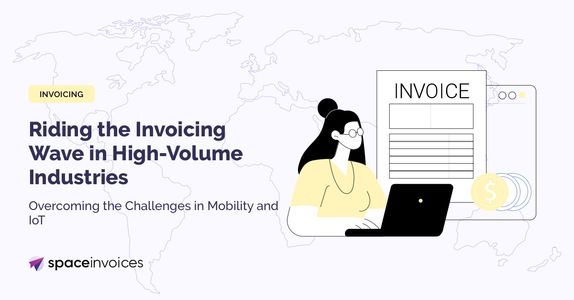Riding the Invoicing Wave in High-Volume Industries: Overcoming the Challenges in Mobility and IoT
As our world becomes more connected, industries like mobility and Internet of Things (IoT) are experiencing a surge in volume and complexity of transactions.
As our world becomes more connected, industries like mobility and Internet of Things (IoT) are experiencing a surge in volume and complexity of transactions. These industries, characterized by their high transaction volumes, present unique invoicing challenges. However, confronting these challenges can unlock operational efficiencies, ensure financial accuracy, and foster customer satisfaction. Let's delve deeper into these challenges, illustrated with real-world examples, and explore the compelling reasons for overcoming them.
1. Managing High Transaction Volumes
High-volume industries like mobility and IoT deal with a staggering number of transactions daily. Think of a ride-hailing app or an IoT-based energy company. Each ride or power usage instance translates into a unique transaction that needs to be accurately invoiced. The sheer volume can overwhelm traditional invoicing systems, leading to inaccuracies and delays.
The Silver Lining: By streamlining the high-volume invoicing process, businesses can improve accuracy, speed, and efficiency. An automated invoicing system can handle thousands of transactions in a fraction of the time it would take a manual system, reducing the chance of errors and ensuring timely invoicing. This can boost customer satisfaction, enhance operational efficiency, and even provide a competitive edge in the market.
2. Handling Micro-Transactions
Mobility and IoT often deal with micro-transactions, small, frequent transactions that accumulate over time. For example, an IoT-enabled parking meter charges users for the exact time their vehicle occupies a space. These charges, although small, add up to a significant amount and need to be accurately tracked and invoiced.
The Silver Lining: Successfully managing micro-transactions can increase financial accuracy and transparency. An invoicing system capable of tracking and processing these small, frequent transactions can ensure that every cent is accounted for, providing a more accurate reflection of revenue. This level of accuracy and transparency can increase trust among users, leading to higher customer retention.
3. Delivering Real-Time Billing
In high-volume industries, customers often expect real-time billing. Consider a bike-sharing service. Users would want to know the exact cost of their ride immediately after they finish, not hours or days later.
The Silver Lining: Implementing real-time invoicing can enhance customer experience and satisfaction. An invoicing system that provides immediate, accurate bills aligns with the fast-paced nature of high-volume industries, meeting customer expectations and enhancing their overall experience. This can lead to higher customer satisfaction scores and promote customer loyalty.
4. Ensuring Scalability
As businesses in the mobility and IoT sectors grow, their invoicing needs become more complex. A solution that works for a few thousand transactions per day may not be suitable for a few million. As such, scalability is a crucial factor in these high-volume industries.
The Silver Lining: By building a scalable invoicing solution, businesses can ensure that their growth is not hampered by operational bottlenecks. A scalable invoicing system can grow with the business, handling an increasing number of transactions without compromising on speed or accuracy. This can facilitate smooth business expansion, allowing businesses to focus on growth rather than operational constraints.
5. Integrating with Multiple Systems
In the mobility and IoT industries, invoicing systems often need to integrate with various other systems, such as ride tracking in a ride-hailing service or energy usage monitoring in an IoT-enabled utility company. These integrations can be complex and, if not managed properly, can lead to errors and inefficiencies.
The Silver Lining: Successfully integrating the invoicing system with other business systems can streamline operations and improve data accuracy. An integrated system reduces the need for manual data entry and the potential for human error, ensuring that invoices are based on accurate, up-to-date data. This can lead to better decision-making, improved customer satisfaction, and an overall increase in operational efficiency.
In conclusion, high-volume industries like mobility and IoT present unique invoicing challenges. However, overcoming these challenges can lead to significant benefits. From improved operational efficiency, financial accuracy, customer satisfaction, and scalability, the potential benefits are immense. By embracing these challenges and investing in robust, automated invoicing systems, businesses in these sectors can turn these challenges into opportunities for growth and success.
At Space Invoices, we understand the invoicing challenges faced by platforms in today's dynamic economic landscape. That's why we've designed an API-first invoicing solution specifically tailored to meet these unique needs.
Additional reading:
Start issuing Invoices, free!
Signup and start issuing compliant invoices from your software in minutes.
Or contact us to get a free implementation consultation.
